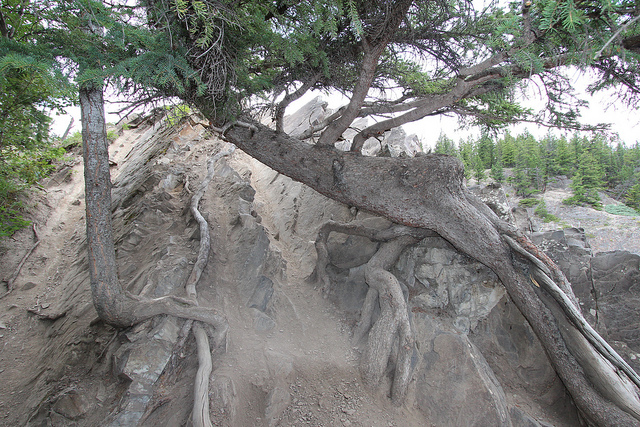
POST-TRAUMATIC GROWTH
It’s easy to stay in our comfort zone. We’re good there. We know where we are. We know what we’re supposed to do about it all.

POST-TRAUMATIC GROWTH
“Post-traumatic growth” is a term coined by Richard Tedeschi and Lawrence Calhoun of the University of North Carolina at Charlotte, two of the pioneering experts on the subject. They say PTG is the “positive change that occurs as a result of struggle with highly challenging life crises.”
In this YouTube video, History of Post Traumatic Growth, Calhoun tells a bit about how their concept of studying “growth through stress” developed.
The scientists and their teams interviewed people who had endured hardship. They wanted to know why some people grow after trauma and others don’t. What they found surprised them.
Calhoun and Tedeschi put together their findings in a heavy-duty 2006 scholarly book, HANDBOOK OF POSTTRAUMATIC GROWTH: Research and Practice.
Just like the wise guys keep telling us, it seems suffering can help people transform in fundamental, positive ways. The transformations in the people who were interviewed were more profound (and more common) than the researchers expected.
They tell us that there are five ways people can grow after a crisis:
- Their relationships can strengthen.
- They can discover new paths and purposes in life. Sometimes these are related to a particular survival mission. Other times the crisis becomes the catalyst for a more general reconsideration of priorities.
- Trauma allows them to find their inner strength.
- Their spiritual life can deepen.
- They can feel a renewed appreciation for life.
HUH? HOW DOES THIS HAPPEN?
“Deliberate rumination,” (spending lots of time trying to make sense out of painful experiences and reflecting on how these circumstances have changed you), the psychologists say, helps to foster post-traumatic growth.
Tedeschi and Calhoun use the metaphor of an earthquake to explain how we grow in the wake of crisis. Just as a city has certain structure before major earthquake so too do we have fundamental beliefs about our lives and the world. Trauma shatters those assumptions.
Out of the rubble comes the opportunity to rebuild. In the aftermath of an earthquake, cities aim to erect buildings and infrastructure that are stronger and more resilient than what now lies in ruins.
Those who are able to rebuild psychologically, spiritually and otherwise after a crisis are better equipped to deal with future adversity, and they ultimately lead more meaningful lives.

Another book with a similar name (and way longer subtitle), THE POST-TRAUMATIC GROWTH GUIDE: Practical Mind-Body Tools to Heal Trauma, Foster Resilience and Awaken Your Potential, was published by clinical psychologist Arielle Schwartz, Ph.D. It is a heck of a lot easier to read.
WHAT PTG CAN MEAN FOR YOU
Personal coach-mentor Robin Amos Kahn gave a short talk about this phenomenon which was published in this YouTube video, Post-Traumatic Growth by OwnTheRoom in 2014. In it she shares her personal story of personal adversity and how she grew from it.
Own The Room is an organization of skillful communicators based in New Jersey who provide leadership training and work with corporations around the world. They say they help “empower high performance cultures that enable people to actually have fun while doing the best work of their lives.”
OKAY….HOW DO I DO IT?
The following collection of six life-hacks are take-aways from these guys and others who have continued to figure out how to use the findings on post-traumatic growth and their ramifications to help other people survive and thrive after a crisis.

I’ve thrown in asides from psychologist Fredrike Bannink whose book, POST TRAUMATIC SUCCESS: Positive Psychology and Solution-Focused Strategies to Help Clients Survive and Thrive, was written for other psychologists working with trauma survivors.
(Stephen Joseph spent over 20 years working with survivors of trauma and is a professor at the University of Nottingham. Fredrike Bannink, who among other things is the Mental Health Trainer for Doctors Without Borders, is an internationally known clinical psychologist based in Amsterdam.)
TAKE STOCK
- Figure out where you are now.
- Acknowledgement and validation are important, the guys in lab coats say. You have to understand and accept the changes that have happened. You have to cop to the fact that you are smack-dab in the middle of it all
- F’r real, your problems don’t need to be analyzed to death. They are there; they are in your face. See them. Know where you’re standing. If you can just see the challenges, you can actually face them and maybe do something about them.
- Focus on what already works – assess your strengths, competencies and resources: How do you cope? How do you keep your head above water? Do more of that. What have you got? Use it.
VALUE CHANGE ITSELF
You know what the best thing about change is? It is happening all the time. If you’re stuck in suck, it helps to remember that old and hoary reminder: “This, too, shall pass.”
Obstructions and adversity do not go on forever. Mostly that’s ’cause we don’t last that long. Also, we always have the option to choose to step out of the bog our own selves.
One way to do that is to try to get past looking at just the negatives of a situation. Check out how things may have improved as well. Even a small change for the better counts. Count them all.
BUILD ON HOPE
- Learn to be hopeful about the future, these guys tell you. Look for inspirational stories about people who have overcome similar obstacles and start looking at how you, your own self, still have a future, one that can be good anyhow.
- Focus on your personal goals. Seeing yourself as you want to be is the key to personal growth. What are your best hopes?
- The scientists, seekers and practitioners all say building hope and optimism is very important for transcending whatever 2 x 4 has hit you upside the head. They are the antidotes to the hopelessness and pessimism that keep you in the muck.
- Develop an attitude of gratitude. Yup. Count your blessings. They are on the other side of all the wo-wo-woes.
RE-AUTHORING
Re-write your own story. You can do this literally by using expressive writing techniques to find new perspectives. As Swiss psychiatrist Carl Jung once said, “I am not what happened to me. I am what I choose to become.“
So…tell the story about who you are choosing to become. Make up your own happy endings.
After a while you’ll start to understand that it doesn’t matter who hurt you or what broke you down. What is going to matter to you is who and what made you smile again and why.
NOTICE NEW GROWTH
- Ask yourself: When have you felt better lately?
- Put on your own lab coat and use “scaling questions” to assess your progress, motivations, hopes and confidence. On a scale from 10 to 0, where would you say you are today? How come it’s not lower?
- Notice the progress you’ve made. Don’t discount them just because they’re teeny. One step is still one step.
- Call your shots – What will be the next signs of progress?
- Celebrate success.
CONCRETE EXPRESSIONS
The scientists who study post-traumatic growth all say that if you can get through the painful process of dealing with trauma and change, you will get to the point when you will make something that is your very own unique expression of self.
It is worthwhile to remember, I think, that one old meaning of the word “suffering” is “to undergo.” When you “suffer,” you are undergoing something. What you’re doing is just all about going on through it. You can choose to suffer over your suffering, or not.
Once you’ve made it to the other side, you’ll be able to make something, the guys in the lab coats say. Maybe it’ll be a marvelous thing the world has never before seen.

FINAL THOUGHT
The poets, the artists, and the wise guys got there before the scientists again, I am thinking.
They know, those poets and artists. Through all of the ouches and angst and all the confusion and chaos, there’s a golden thread that leads you back to your Highest Self. And when you get there, oh…the thoughts you can think and the things you can do….
All this other stuff is about finding that thread.

Here’s a poem:
LOOKING FOR THE GOD THREAD
Looking for the God Thread…
Where the heck did it go?
It’s buried under all this other stuff.
Tangled up in all this blustering blow.
Looking for the God Thread…
Do you see a shiny fine gold wire
Wandering through this mass of
Fuzz-ball thoughts, messed-up desire?
Looking for the God Thread…
It’s in here, I know.
I’m picking through all these old bits,
Growling ’cause the going’s so slow.
Looking for the God Thread…
Where the heck can it be?
It’s all my fault! I got distracted, a bit refracted,
Now that God Thread’s LOST somewhere in me.
by Netta Kanoho
Header picture credit: “Windswept” by Maciej via Flickr [CC BY-SA 2.0]
……
SOME OTHER POSTS TO EXPLORE:
(Click on each of the post titles below and see where it takes you….)
……
Thanks for your visit. I’d appreciate it if you’d drop a comment or note below and tell me your thoughts.
20 thoughts on “POST-TRAUMATIC GROWTH”
Thank you for posting this positve and interesting article.
I have suffered from anxiety and depression for over two years now but am finally starting to learn to deal with it and get on with my life.
This article has inspired me further that I can not only get over my issues but can be a stronger person as a result of it.
Hey Ken:
Thanks for the visit and for sharing your story. I do appreciate it. I’m glad the thing helps!
Please do come again….
It has always amazed me how one person can go through a traumatic event and use it as a crutch to determine the rest of their life, while on the other hand, another person can also go through an equally traumatic event and even though they are unfeeling or callous, they are able to get up, and start moving again, and become a source of encouragement to others who have never been through what they’ve been through!
I hope to be that kind of person if ever I am struck with tragedy or trauma.
Every day, I wake up thinking “what will I encounter today?” or “what will happen today?” in an effort to be open to the possibility that things may or may not go my way; and either way, I will get through it, and I will overcome and I will move on.
Easier said than done, but I try to remind myself daily to change the things that I have control over, and to learn and grow from the things that happen to me that I don’t have control over.
Thanks for the article. It’s so true, “what doesn’t kill makes you stronger!”
Hey Wendi:
Thanks for your visit and for sharing your thoughts. I do agree. We can only do the best that we can do.
Please do come again.
What a delight.
Your have such a sparkle.
Thank you Robin!
My favorite:The God thread! Love that.
I heard recently I am who God says I am .
I believe many get lost in the trauma,in the pain and question who am I?
He is the solution for everything.
The Thread that never is lost and will never leave you.
Love,
Erica
Ps powerful movie that depicts what I am describing.
“The heart of man”
Check it out!
Hey Erica:
Thank you for your visit and your comments. They make me smile.
Please do come again!
I just noticed the PTG interview with Lawrence Calhoun here, done in the context of our UVA study of adversity leading to wisdom. The work is described in several academic articles (with more clips) and the book Choosing Wisdom: Strategies and Inspiration for Growing Through Life-Changing Difficulties which includes a PBS documentary of the same name. We studied physicians who made serious medical errors and people living well with persistent pain. It is available on Amazon.
The images of trees growing in ways influenced by extreme conditions always struck me as a apt metaphor for adversity in life. They are not “normal” trees but so very beautiful. Thank you.
Hey Justine:
I do thank you for your visit and I appreciate your additional information. I agree that the trees that are twisted by the harsh conditions they endure are so very beautiful as metaphors for how adversity affects us.
Please do come again….
This is a lovely article. I have in the past have suffered with anxiety and stress just like everyone in this world. I have learned to overcome them and live past it. This article further motivates me and inspires me to live past those issues in my life. Thank you so much for sharing this article.
Thanks for your visit and your comments, Sujander.
Please do come again….
I really like your post. It seems to me it could serve as a guide to overcoming the failures you encounter on the road to success. Starting again after a failure could be a kind of post-traumatic experience. Your techniques for overcoming the negative experience could fit in well here.
It’s not always easy to figure out a path through the rubble. However, you have written out a couple of lists that could be extremely valuable, when used to get back on track. Very commendable. And, by the way, I love your images.
Thanks for the visit and for sharing your thoughts, Fran.
You’re right. Failing to achieve a much-desired goal is definitely a traumatic experience and dealing with the aftermath of it can feel exactly like other traumatic life-things. Big or small, the post-traumatic growth mindset and the systems and tools available to you are the same.
Suffering is suffering. Helping yourself heal is the best response to it, I think.
Thanks for pointing that out.
Please do come again….
Hello Netta! Out of everything that’s difficult, adverse and heartbreaking there can come out wonderful, shiny and life changing results. And one of them is Post Traumatic Growth. Knowing about Post Traumatic Growth can even help us to change our perspective of the trauma.
Thank you very much for this wonderful post! I’ve recently discovered your site but from now on, I’ll continue tuned.
Henry, thanks for your visit and for sharing your thoughts. I appreciate it.
Please do come again.
This is a lovely article.
A person may experience a change in their demeanor after experiencing a traumatic situation or witnesses an unpleasant event. These behavioral changes may be caused by a mental health condition, such as: Anxiety: Anxiety occurs when a person feels nervous or uneasy about a situation.
Post-traumatic growth refers to positive personality change following traumatic life events. … Not everyone who experiences a traumatic event will directly develop post-traumatic growth. Rather, an individual’s emotional response to the traumatic event is significant in determining the long-term outcome of that trauma.
A new study has found that people living with major depressive disorder are biologically older than people without depression, and that childhood trauma exacerbates this effect
Helen, thank you for your visit and for the additional information about post-traumatic growth. I do appreciate it.
As you say, not everyone who experiences trauma will experience it as a growth experience. My own feeling about it all is that knowing that there is a chance for growth as well as effective ways to help foster posiitive changes can go a long way to helping someone stand up again and grow stronger in the process.
It isn’t easy but then anything worthwhile never is.
Please do come again.
I feel this article describes my life’s story. I’ve been beaten down and stood up again so many times that I seem to live the PTG process. Story of my life.
I’ve read so many about post dramatic stress but no one seems to talk about PTG.
What I love most about this is the positive spin. There’s hope for us. No matter how bad life gets. No matter how dark we feel. If we’re willing to give it another go, we can.
Funny enough, I never knew this PTG term before reading your article. Very enlightening. Thank you Netta.
Welcome back, Monika. I had to smile. I think I would call you unsinkable! Congratulations on living the PTG process. Life can be a lot of rough-and-tumble and it’s marvelous that you keep on standing up again. Good on ya!
Please do come again.
I found the idea of re-authoring one’s story particularly exciting. To think that we have the power to rewrite our narratives and choose who we become really encourages me to keep pushing forward because I also have gone through a rough childhood of emotional trauma.
As I read your article, things became more apparent now that it’s clearly stated – such as how growth (for me at least) really only started happening consistently once I opened up to others and strengthened relationships.
Do you find that strategies for PTG are unique for the individual or for particular situations? It seems hard to know what the first step should be.
Thanks for the visit and for sharing your thoughts, Chase.
Probably, like every other life-strategy and plan, the PTG things are unique to each individual. The deal is, nobody knows which move will work. You pick one and go. Your next move becomes clearer as things move forward.
Please do come again.